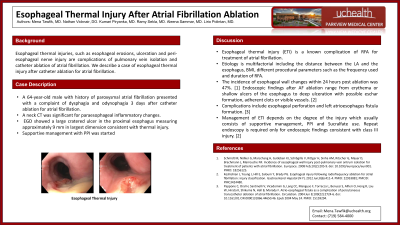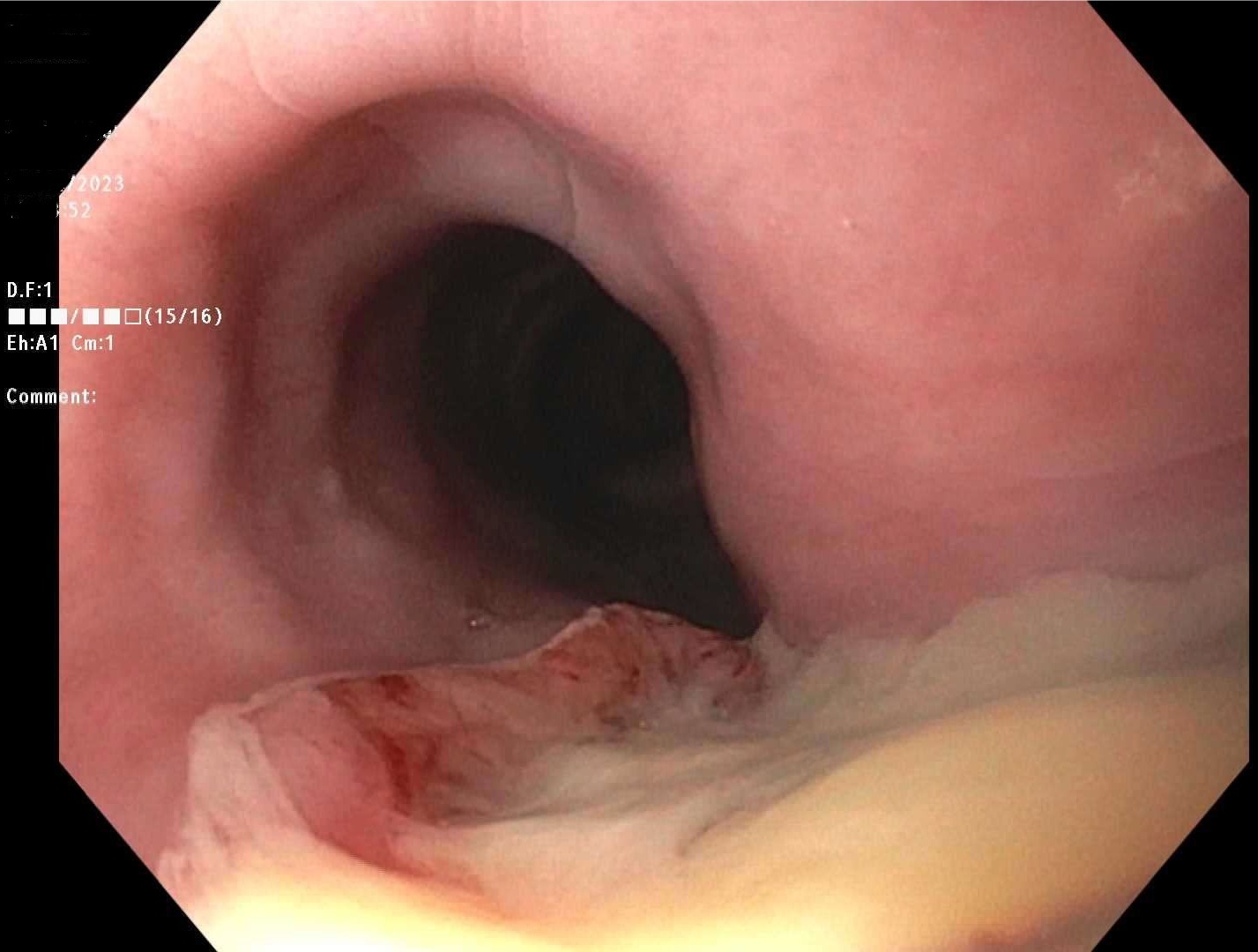Tuesday Poster Session
Category: Esophagus
P3953 - Esophageal Thermal Injury After Atrial Fibrillation Ablation
Tuesday, October 29, 2024
10:30 AM - 4:00 PM ET
Location: Exhibit Hall E

Has Audio

Mena Tawfik, MD
Parkview Health Center
Pueblo, CO
Presenting Author(s)
Mena Tawfik, MD1, Nathan Vicknair, DO1, Kumari Piryanka, MD1, Ramy Sekla, MD1, Aleena Sammar, MD2, Lirio Polintan, MD1
1Parkview Medical Center, Pueblo, CO; 2Parkview Health Center, Pueblo, CO
Introduction: Esophageal thermal injuries, such as esophageal erosion, ulceration and peri-esophageal nerve injury are complications of pulmonary vein isolation and catheter ablation of atrial fibrillation. We describe a case of esophageal thermal injury after catheter ablation of atrial fibrillation.
Case Description/Methods: A 64-year-old male with history of paroxysmal atrial fibrillation presented to the emergency department for a complaint of dysphagia and odynophagia. The patient had undergone a catheter ablation for atrial fibrillation 3 days prior to presentation. He stated that his symptoms have started the day after the procedure and been getting progressively worse since. A neck CT at outside facility was significant for paraesophageal inflammatory changes. An EGD was significant for a large cratered ulcer in the proximal esophagus measuring approximately 9 mm in largest dimension consistent with thermal injury. The patient was started on high dose PPI and discharged home in a stable condition.
Discussion: Esophageal thermal injury (ETI) is a known complication of RFA for treatment of atrial fibrillation. The etiology of the injury is multifactorial including the distance between the LA and the esophagus, body mass index, as well different procedural parameters such as the frequency used and duration of RFA. In a case series by Schmidt and colleagues of 28 patients, the incidence of esophageal wall changes within 24 hours post ablation was 47%. [1] Endoscopic findings after AF ablation range from erythema or shallow ulcers of the esophagus to deep ulceration with possible eschar formation, adherent clots or visible vessels. [2] ETI is classified into 3 classes per Keshishian and associates case series of 3 patients. [2] ETI has the potential to advance into esophageal perforation or left atrioesophagus fistula formation. Atrioesophageal fistula should be suspected in any patient who presents with symptoms of endocarditis, neurological deficits, massive hematemesis, or septic shock after left atrial ablation. Despite the low incidence of such complications, the mortality rate is very high. [3] Management of ETI depends on the degree of the injury which usually consists of supportive management, PPI and sucralfate use. Close monitoring is necessary for early detection of further complications. Repeat endoscopy is required only for endoscopic findings consistent with class III injury. [2]

Disclosures:
Mena Tawfik, MD1, Nathan Vicknair, DO1, Kumari Piryanka, MD1, Ramy Sekla, MD1, Aleena Sammar, MD2, Lirio Polintan, MD1. P3953 - Esophageal Thermal Injury After Atrial Fibrillation Ablation, ACG 2024 Annual Scientific Meeting Abstracts. Philadelphia, PA: American College of Gastroenterology.
1Parkview Medical Center, Pueblo, CO; 2Parkview Health Center, Pueblo, CO
Introduction: Esophageal thermal injuries, such as esophageal erosion, ulceration and peri-esophageal nerve injury are complications of pulmonary vein isolation and catheter ablation of atrial fibrillation. We describe a case of esophageal thermal injury after catheter ablation of atrial fibrillation.
Case Description/Methods: A 64-year-old male with history of paroxysmal atrial fibrillation presented to the emergency department for a complaint of dysphagia and odynophagia. The patient had undergone a catheter ablation for atrial fibrillation 3 days prior to presentation. He stated that his symptoms have started the day after the procedure and been getting progressively worse since. A neck CT at outside facility was significant for paraesophageal inflammatory changes. An EGD was significant for a large cratered ulcer in the proximal esophagus measuring approximately 9 mm in largest dimension consistent with thermal injury. The patient was started on high dose PPI and discharged home in a stable condition.
Discussion: Esophageal thermal injury (ETI) is a known complication of RFA for treatment of atrial fibrillation. The etiology of the injury is multifactorial including the distance between the LA and the esophagus, body mass index, as well different procedural parameters such as the frequency used and duration of RFA. In a case series by Schmidt and colleagues of 28 patients, the incidence of esophageal wall changes within 24 hours post ablation was 47%. [1] Endoscopic findings after AF ablation range from erythema or shallow ulcers of the esophagus to deep ulceration with possible eschar formation, adherent clots or visible vessels. [2] ETI is classified into 3 classes per Keshishian and associates case series of 3 patients. [2] ETI has the potential to advance into esophageal perforation or left atrioesophagus fistula formation. Atrioesophageal fistula should be suspected in any patient who presents with symptoms of endocarditis, neurological deficits, massive hematemesis, or septic shock after left atrial ablation. Despite the low incidence of such complications, the mortality rate is very high. [3] Management of ETI depends on the degree of the injury which usually consists of supportive management, PPI and sucralfate use. Close monitoring is necessary for early detection of further complications. Repeat endoscopy is required only for endoscopic findings consistent with class III injury. [2]

Figure: Esophagus: thermal ulcer
Disclosures:
Mena Tawfik indicated no relevant financial relationships.
Nathan Vicknair indicated no relevant financial relationships.
Kumari Piryanka indicated no relevant financial relationships.
Ramy Sekla indicated no relevant financial relationships.
Aleena Sammar indicated no relevant financial relationships.
Lirio Polintan indicated no relevant financial relationships.
Mena Tawfik, MD1, Nathan Vicknair, DO1, Kumari Piryanka, MD1, Ramy Sekla, MD1, Aleena Sammar, MD2, Lirio Polintan, MD1. P3953 - Esophageal Thermal Injury After Atrial Fibrillation Ablation, ACG 2024 Annual Scientific Meeting Abstracts. Philadelphia, PA: American College of Gastroenterology.
